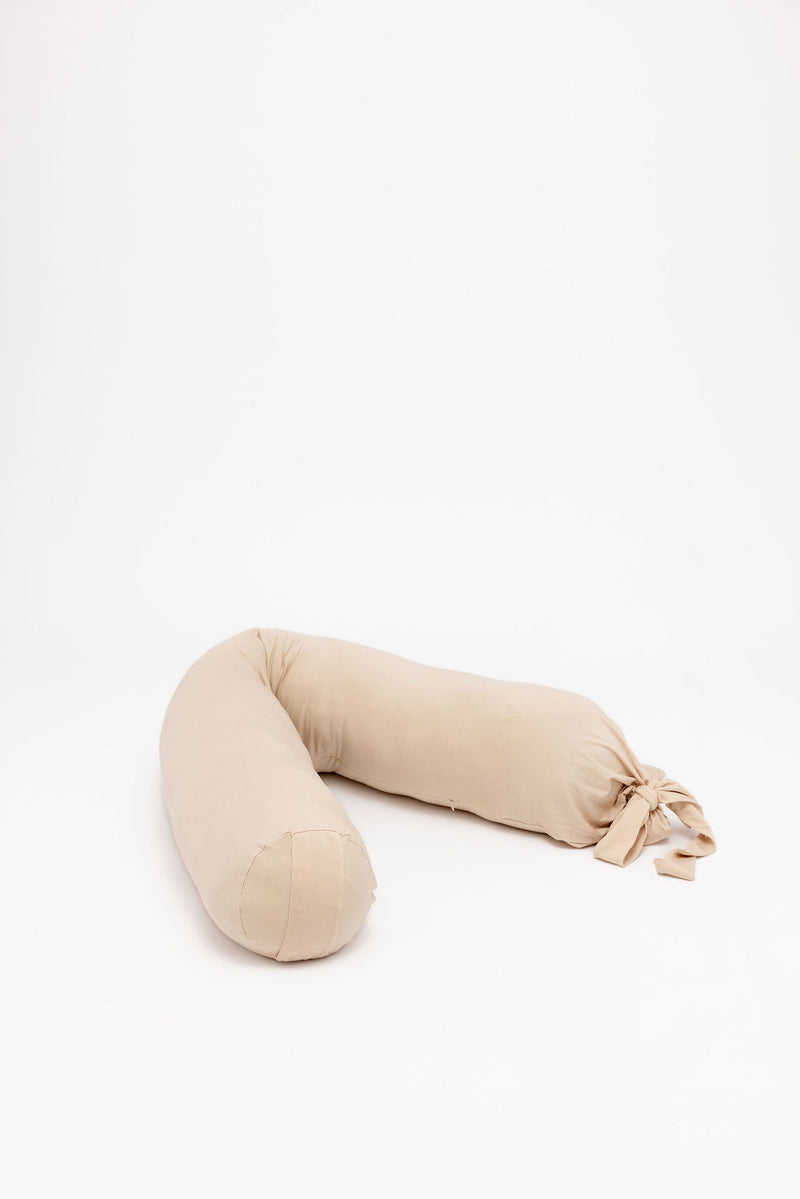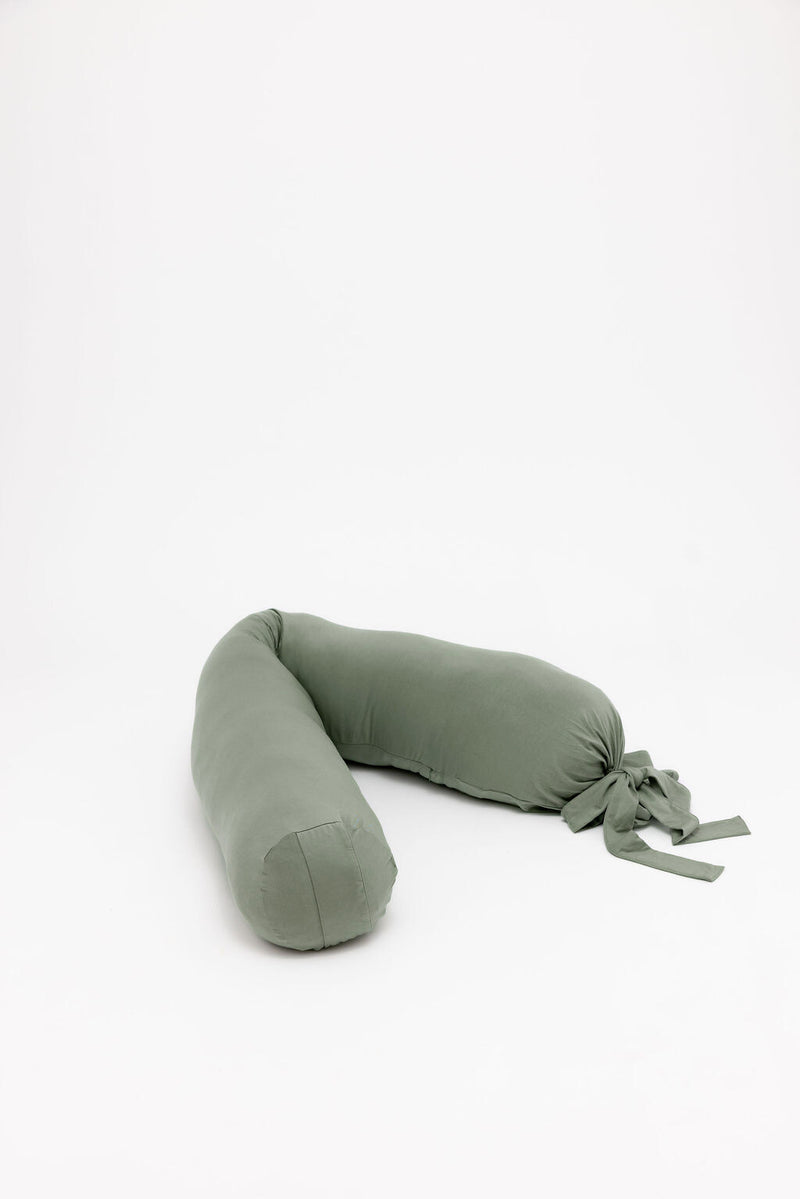Types of Pregnancy Pillows
Not all pregnancy pillows are the same, and the best option depends on your sleeping style, comfort needs, and stage of pregnancy. From compact support to full-body cushioning, here are the most common types of pregnancy pillows to consider.
Benefits of Using Pregnancy Pillows
There are many great benefits to using a pregnancy body pillow.
Wedge Pillows
Wedge pillows are small and versatile, offering targeted support under the belly, behind the back, or between the knees. They help relieve pressure and reduce strain without taking up much space in bed. Ideal for travel or minimal support needs, a wedge pillow is a great supplement to your regular setup or a gentle introduction to pregnancy pillow use.
Total Body Pillows
Total body pillows are large, contoured pillows that support the entire body from head to toe. Often shaped like a “C” or “U,” they are designed to cradle your body and align your spine, hips, and legs for better sleep posture. These pillows are especially helpful during the later stages of pregnancy when back pain and discomfort can interfere with rest.
Full-Length Body Pillows
Full-length body pillows run parallel to your body and are typically straight, providing support for your arms, legs, and bump all at once. They are ideal for side sleepers and can be hugged or positioned to cushion pressure points. While they do not offer the same wraparound feel as total body pillows, they provide consistent support and are easy to reposition throughout the night.
Benefits of Using Pregnancy Pillows
A pregnancy body pillow can make a noticeable difference in how well you rest during pregnancy. As your body shifts to accommodate your growing baby, sleep often becomes more challenging, especially with added pressure on your back, hips, and joints. A thoughtfully designed pillow provides full-body support, helping you find a comfortable position and stay there longer. By easing tension, improving alignment, and minimizing sleep disruptions, it creates a more restful sleep environment that supports both your comfort and your overall well-being throughout each trimester. Even after your baby arrives, many parents continue to use their pillow for postpartum recovery or as extra support during nursing, feeding, or rest.
Improves Sleep Quality
Getting quality sleep can become more challenging as your pregnancy progresses. A well-designed pregnancy pillow helps by supporting the natural curves of your body and reducing pressure on sensitive areas. By helping you find a more comfortable position and stay in it longer, it encourages deeper, more restful sleep night after night.
Reduces Discomfort
As your belly grows, it is common to experience back pain, hip strain, or heartburn. A full-body pregnancy pillow cushions these pressure points and helps support your back, belly, and legs. By aligning your spine and keeping your upper body slightly elevated, it can also help minimize discomfort like heartburn and reduce tension across your lower back.
Promotes Better Circulation
Side sleeping is often recommended during pregnancy to support blood flow, especially in later trimesters. A pregnancy pillow makes it easier to stay in a side-sleeping position by offering balanced support for your hips, knees, and belly. This reduces pressure on your back and helps keep circulation flowing freely, contributing to both your comfort and your baby’s well-being.
How to Choose a Pregnancy Pillow
The right pregnancy pillow can transform how you sleep and rest throughout pregnancy. To find the best fit for your needs, it’s important to consider how you sleep, the design of the pillow, the materials used, and how easy it is to care for. Here's what to look for:
Sleeping Position
Start by thinking about how you typically sleep. Side sleeping is often recommended during pregnancy, especially in the second and third trimesters, to support circulation. Look for a pillow that encourages and supports this position by cradling the belly, back, and knees. Some pillows are designed specifically to help you stay in a side-sleeping position without shifting during the night, which can improve comfort and restfulness.
Shape and Size
Pregnancy pillows come in different shapes, each offering a unique kind of support. U-shaped and C-shaped pillows are popular for full-body coverage, making them ideal for those who need support from head to toe. These larger shapes help align your spine and relieve pressure on the hips, legs, and back. Wedge pillows, on the other hand, are more compact and provide targeted support under the belly, behind the back, or between the knees. Consider the size of your bed and how much space you want the pillow to take up when deciding what works best.
Washable Cover
A pregnancy pillow should be easy to care for, especially with regular use. Look for a pregnancy pillow cover that comes with a removable, machine-washable cover to help keep things clean and fresh. Fabrics that hold up well through frequent washing are a smart choice, and simple zip closures make it easier to take the cover off and put it back on without hassle. Cleanliness is key to comfort, especially during pregnancy and postpartum recovery.
Material
Comfort starts with the right materials. Choose a pillow made with breathable, hypoallergenic fabric that is gentle on sensitive skin and helps regulate body temperature. Natural fillings or supportive foam cores can offer the structure needed to reduce pressure without feeling too firm. If you tend to sleep warm, look for materials that wick moisture and allow airflow for a cooler night’s sleep.
Pregnancy Pillow FAQs
How early should I start using a Pregnancy pillow during pregnancy?
You can start using a pregnancy pillow as soon as sleep begins to feel uncomfortable. Many people find relief around the second trimester, typically near week 20, when a growing belly and shifting weight create pressure on the back, hips, and joints. Some may benefit earlier if they experience aches or difficulty resting in the first trimester. A pregnancy pillow supports your body through each stage by easing tension and encouraging better alignment. There is no set rule for when to start using one. If it helps you sleep more comfortably, it is the right time to begin.
What Shape Pregnancy Pillow Is Best?
The best shape for a pregnancy pillow depends on your body, your sleep habits, and how much support you need. U-shaped pillows offer full-body support and are ideal for those who want cushioning on both sides. C-shaped pillows support the head, belly, and knees while leaving more space in bed. Straight body pillows are simple and versatile, great for hugging or tucking between the knees. If you only need targeted support, a wedge may be best. The right shape should help align your body, reduce pressure, and make sleeping more comfortable as your pregnancy progresses.
When to Stop Sleeping on Your Back During Pregnancy?
It is generally recommended to stop sleeping on your back by the second trimester, around week 20. As your baby grows, the weight of your uterus can press on major blood vessels, which may reduce circulation and cause discomfort or dizziness. Side sleeping, especially on your left side, promotes better blood flow and helps support the heart and kidneys. If you accidentally wake up on your back, simply shift to your side. A pregnancy pillow can help keep you in a side-sleeping position more comfortably throughout the night.
Are Pregnancy Pillows Safe for the Baby?
Yes, pregnancy pillows are safe for both you and your baby when used properly. They are specifically designed to support your body during pregnancy by relieving pressure, improving alignment, and helping you maintain a healthy sleep position. Pregnancy pillows do not interfere with the safety of your baby in the womb. If anything feels uncomfortable or causes strain, it is best to adjust your position or try a different pillow style. Always follow the instructions and talk to your doctor if you have concerns about positioning or sleep support during pregnancy.
What Is the Ideal Size for a Pregnancy Body Pillow?
While pregnancy pillows come in a variety of shapes and sizes, ours is thoughtfully designed in one ideal size to support full-body comfort. Measuring 59 inches long by 8.46 inches wide, it offers a balance of cushioning and flexibility that works for most body types and sleeping positions. This size is long enough to support the head, belly, hips, and knees without overwhelming your bed space. Whether you are sleeping, lounging, or nursing postpartum, our pillow is sized to provide the support you need throughout every stage of pregnancy and beyond.
















